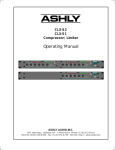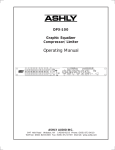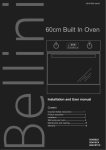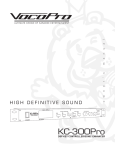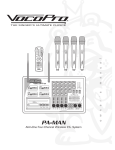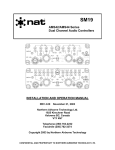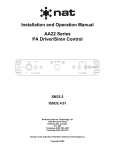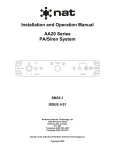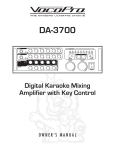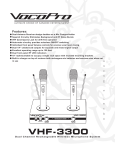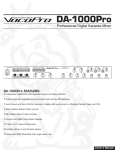Download VocoPro CLG-600 Musical Instrument User Manual
Transcript
l a u FEATURES: n • Two Independent Compressor/Limiter/Gates in a 1RU Roadworthy Housing a • Unique (IKC) Circuitry Intelligently Combines 'Hard Knee' and 'Soft Knee' Compression Styles, Providing Excellent Inaudible and Program Music Compression m • Fully Automatic or Manually Variable Attack/Release Times, Compression Ratios and Threshold Levels Allow Both the Novice and the Experienced User Full Effective Use All Processing Controls • Dual 12-stage Gain Reduction and 8-stage Input/Output Meters for Accurate, Reliable Metering • Dual-Mono or Stereo Operation for a Multitude of Live, Studio or Recording Applications s • Built-In Adjustable Dynamic Enhancer Selectively Replaces High-End Loss Even During Severe Compression Produced by High-energy or Low-End Content So Processed Vocals Remain Vibrant ' • IRC (Interactive Ratio Control) Expander/Gate Automatically Adjusts Expansion Per the Program Material, Eliminating the Noise Floor During Quiet Sections or Music Pauses r • 1/4" and XLR-TRS Input/Outputs Provide for Balanced and Unbalanced Integrations to External Devices n e • Auto-mode Allows for "Hands-Free" Operation of CLG-600, Allowing Users to Focus on Other Aspects of the Show, Recording or Broadcast 30 -35 -50 0 OFF 27 24 21 18 15 12 -10 -20 -10 9 6 4 2 LEVEL 1 +10 THRESHOLD dB EXPANDER/GATE -30 CH 1 2.5 2.5 -30 20 -10 -5 -3 0 +3 INAUDIBLE GAIN +5 3 0 -40 +20 THRESHOLD dB MANUAL 8 1.5 1 0.1 RATIO M1 200 msec OUT 4 .05 AUTO COMPRESSOR/LIMITER RELEASE Sec -20 +20 OUPUT dB MONO OFF 27 6 IN ENHANCER -20 -10 -50 0 OFF STEREO MODE 24 21 18 15 12 -10 -20 -35 +10 30 9 6 4 2 LEVEL 1 + 0.5 0 +10 THRESHOLD dB EXPANDER/GATE 2.5 -30 +10 -40 CH 2 2.5 -30 20 -10 0.5 -5 -3 0 +3 +5 0 3 0 +20 THRESHOLD dB 1.5 MANUAL 8 CLG-600 OUT w GAIN + - DUAL CHANNEL COMPRESSOR 1 0.1 RATIO N1 200 msec .05 AUTO 4 RELEASE Sec -20 +20 OUPUT dB OFF 6 LIMITER WITH GATE IN COMPRESSOR/LIMITER CLG-600 ENHANCER Dual Channel Compressor/Limiter with Gate o INAUDIBLE -35 Safety Instructions CAUTION RISK OF SHOCK CAUTION: To reduce the risk of electric shock, do not remove cover (or back). No userserviceable parts inside. Only refer servicing to qualified service personnel. Explanation of Graphical Symbols The lightning flash & arrowhead symbol, within an equilateral triangle, is intended to alert you to the presence of danger. The exclamation point within an equilateral triangle is intended to alert you to the presence of important operating and servicing instructions. WARNING To reduce the risk of fire or electric shock, do not expose this unit to rain or moisture. 8. Ventilation - The appliance should be situated so its location does not interfere with its proper ventilation. For example, the appliance should not be situated on a bed, sofa, rug, or similar surface that may block the ventilation slots. 9. Heat - The appliance should be situated away from heat sources such as radiators, heat registers, stoves, or other appliances (including amplifiers) that produce heat. 10. Power Sources - The appliance should be connected to a power supply only of the type described in the operating instructions or as marked on the appliance. 11. Grounding or Polarization - Precautions should be taken so that the grounding or polarization means of an appliance is not defeated. 12. Power-Cord Protection - Power-supply cords should be routed so that they are not likely to be walked on or pinched by items placed upon or against them, paying particular attention to cords at plugs, convenience receptacles, and the point where they exit from the appliance. 13. Cleaning - Unplug this unit from the wall outlet before cleaning. Do not use liquid cleaners or aerosol cleaners. Use a damp cloth for cleaning. 14. Power lines - An outdoor antenna should be located away from power lines. 1. Read Instructions - All the safety and operating instructions should be read before the appliance is operated. 15. Nonuse Periods - The power cord of the appliance should be unplugged from the outlet when left unused for a long period of time. 2. Retain Instructions - The safety and operating instructions should be retained for future reference. 16. Object and Liquid Entry - Care should be taken so that objects do not fall and liquids are not spilled into the enclosure through openings. 3. Heed Warnings - All warnings on the appliance and in the operating instructions should be adhered to. 4. Follow Instructions - All operating and use instructions should be followed. 5. Attachments - Do not use attachments not recommended by the product manufacturer as they may cause hazards. 6. Water and Moisture - Do not use this unit near water. For example, near a bathtub or in a wet basement and the like. 7. Carts and Stands - The appliance should be used only with a cart or stand that is recommended by the manufacturer. 7 A. An appliance and cart combination should be moved with care. Quick stops, excessive force, and uneven surfaces may cause an overturn. 17. Damage Requiring Service - The appliance should be serviced by qualified service personnel when: A. B. C. D. The power supply cord or plug has been damaged; or Objects have fallen into the appliance; or The appliance has been exposed to rain; or The appliance does not appear to operate normally or exhibits a marked change in performance; or E. The appliance has been dropped, or the enclosure damaged. 18. Servicing - The user should not attempt to service the appliance beyond that described in the operating instructions. All other servicing should be referred to qualified service personnel. Note: To CATV system installer's (U.S.A.): This reminder is provided to call the CATV system installer's attention to Article 820-40 of the NEC that provides guidelines for proper grounding and, in particular, specifies that the cable ground shall be connected as close to the point of cable entry as practical. 1 Welcome... And Thank you for purchasing the CLG-600 from VocoPro, your ultimate choice in Karaoke entertainment! With years of experience in the music entertainment business, VocoPro is a leading manufacturer of Karaoke equipment, and has been providing patrons of bars, churches, schools, clubs and individual consumers the opportunity to sound like a star with full-scale club models, in-home systems and mobile units. All our products offer solid performance and sound reliability, and to further strengthen our commitment to customer satisfaction, we have customer service and technical support professionals ready to assist you with your needs. We have provided some contact information for you below. 1728 Curtiss Court La Verne, CA 91750 Toll Free: 800-678-5348 TEL: 909-593-8893 FAX: 909-593-8890 VocoPro Company Email Directory Customer Service & General Information [email protected] Tech Support [email protected] Remember Our Website Be sure to visit the VocoPro website www.vocopro.com for the latest information on new products, packages and promos. And while you're there don't forget to check out our Club VocoPro for Karaoke news and events, chat rooms, club directories and even a Service directory! We look forward to hearing you sound like a PRO, with VocoPro, your ultimate choice in Karaoke entertainment. FOR YOUR RECORDS Please record the model number and serial number below, for easy reference, in case of loss or theft. These numbers are located on the rear panel of the unit. Space is also provided for other relevant information Model Number Serial Number Date of Purchase Place of Purchase 2 Listening For A Lifetime Selecting fine audio equipment such as the unit you've just purchased is only the start of your musical enjoyment. Now it's time to consider how you can maximize the fun and excitement your equipment offers. VocoPro and the Electronic Industries Association's Consumer Electronics Group want you to get the most out of your equipment by playing it at a safe level. One that lets the sound come through loud and clear without annoying blaring or distortion and, most importantly, without affecting your sensitive hearing. Sound can be deceiving. Over time your hearing 'comfort level' adapts to a higher volume of sound. So what sounds 'normal' can actually be loud and harmful to your hearing. Guard against this by setting your equipment at a safe level BEFORE your hearing adapts. To establish a safe level: • Start your volume control at a low setting. • Slowly increase the sound until you can hear it comfortably and clearly, and without distortion. Once you have established a comfortable sound level: • Set the dial and leave it there. • Pay attention to the different levels in various recordings. Taking a minute to do this now will help to prevent hearing damage or loss in the future. After all, we want you listening for a lifetime. Used wisely, your new sound equipment will provide a lifetime of fun and enjoyment. Since hearing damage from loud noise is often undetectable until it is too late, this manufacturer and the Electronic Industries Association's Consumer Electronics Group recommend you avoid prolonged exposure to excessive noise. This list of sound levels is included for your protection. Some common decibel ranges: Level 30 40 50 60 70 80 Example Quiet library, Soft whispers Living room, Refrigerator, Bedroom away from traffic Light traffic, Normal Conversation Air Conditioner at 20 ft., Sewing machine Vacuum cleaner, Hair dryer, Noisy Restaurant Average city traffic, Garbage disposals, Alarm clock at 2 ft. The following noises can be dangerous under constant exposure: Level 90 100 120 140 180 Example Subway, Motorcycle, Truck traffic, Lawn Mower Garbage truck, Chainsaw, Pneumatics drill Rock band concert in front of speakers Gunshot blast, Jet plane Rocket launching pad -Information courtesy of the Deafness Research Foundation 3 CLG-600 Dual Channel Compressor/Limiter with Gate Contents Safety Instructions . . . . . . . . . . . . . . . . . . . . . . . . . . . . . . . . . . . . . . . . . . . . . . . . . . . . . . . . . . 1 Welcome . . . . . . . . . . . . . . . . . . . . . . . . . . . . . . . . . . . . . . . . . . . . . . . . . . . . . . . . . . . . 2 Listening for a Lifetime . . . . . . . . . . . . . . . . . . . . . . . . . . . . . . . . . . . . . . . . . . . . . . . . . 3 Features . . . . . . . . . . . . . . . . . . . . . . . . . . . . . . . . . . . . . . . . . . . . . . . . . . 4 Introduction . . . . . . . . . . . . . . . . . . . . . . . . . . . . . . . . . . . . . . . . . . . . . . . . . . . . . . . . . . . . . . 5 Unpacking . . . . . . . . . . . . . . . . . . . . . . . . . . . . . . . . . . . . . . . . . . . . . . . . . . . . . . . . . . 6 AC Power Requirements . . . . . . . . . . . . . . . . . . . . . . . . . . . . . . . . . . . . . . . . . . . . . . . . . . . . . . . . . . 6 Mounting / Installation. . . . . . . . . . . . . . . . . . . . . . . . . . . . . . . . . . . . . . . . . . . . . . . . . . . . . . . . . 6 Front Panel Description and Controls. . . . . . . . . . . . . . . . . . . . . . . . . . . . . . . . . . . . . . . . . . . . . . Rear Panel Description and Controls . . . . . . . . . . . . . . . . . . . . . . . . . . . . . . . . . . . . . . . . . . . . . Connections and Cables . . . . . . . . . . . . . . . . . . . . . . . . . . . . . . . . . . . . . . . . . . . . . . . . . . . . . . . . . Typical Applications . . . . . . . . . . . . . . . . . . . . . . . . . . . . . . . . . . . . . . . . . . . . . . . . . . . . 9 10 10-12 Troubleshooting Tips. . . . . . . . . . . . . . . . . . . . . . . . . . . . . . . . . . . . . . . 13 Useful Compressor Settings. . . . . . . . . . . . . . . . . . . . . . . . . . . . . . . . . . . . . . . . 14 Specifications . . . . . . . . . . . . . . . . . . . . . . . . . . . . . . . . . . . . . . . . . . . 15 CLG-600 FEATURES • Two Independent Compressor/Limiter/Gates in a 1RU Roadworthy Housing • Unique (IKC) Circuitry Intelligently Combines 'Hard Knee' and 'Soft Knee' Compression Styles, Providing Excellent Inaudible and Program Music Compression • Fully Automatic or Manually Variable Attack/Release Times, Compression Ratios and Threshold Levels Allow Both the Novice and the Experienced User Full Effective Use All Processing Controls • Dual 12-stage Gain Reduction and 8-stage Input/Output Meters for Accurate, Reliable Metering • Dual-Mono or Stereo Operation for a Multitude of Live, Studio or Recording Applications • Built-In Adjustable Dynamic Enhancer Selectively Replaces High-End Loss Even During Severe Compression Produced by High-energy or Low-End Content So Processed Vocals Remain Vibrant. • IRC (Interactive Ratio Control) Expander/Gate Automatically Adjusts Expansion Per the Program Material, Eliminating the Noise Floor During Quiet Sections or Music Pauses • 1/4" and XLR-TRS Input/Outputs Provide for Balanced and Unbalanced Integrations to External Devices • Auto-mode Allows for "Hands-Free" Operation of CLG-600, Allowing Users to Focus on Other Aspects of the Show, Recording or Broadcast 4 7-9 Introduction The CLG-600 Compressor/Limiter/Gate was designed for use in the Karaoke community, but of course can also be used in the multitude of situations that compressors commonly handle. If this is your first experience using a compressor, or are completely new to the process of compression, limiting and gating, it is well advised to read this manual thoroughly to best acquaint yourself with them prior to any live application of the CLG-600. The CLG-600's range of applications can be divided into three basic categories, compressing, limiting and gating. When used as a protective device to prevent audio levels from overloading systems such as tape recorders, power amplifiers, speakers, or transmitters, it is generally referred to as 'Limiting'. It may also be used to even out a Karaoke performance by deliberately reducing the dynamic range (volume range) of the overall vocal signal, and setting the output gain to bring the compressed signal back to a normalized volume level. Doing this allows the operator to avoid unexpected volume peaks and secure a much louder and full sounding vocal signal at the same time. That is referred to as 'Compressing'. Also common, is the application of completely removing audible noise from low-volume sections of an audio signal, i.e. fans, air conditioning units, electric hums. This is referred to as 'Gating'. In any case, the CLG-600 offers exceptional performance and precise controls for the Karaoke and audio enthusiasts, and with time and experience, you will soon harness the full potential of the CLG-600, never doing another show or studio recording without it! Common Compression Terms • Threshold - Volume level at which the compressor begins compression. • Ratio - The relative level the volume above threshold will be brought down by. • Attack & Release - Attack controls how fast the compressor reacts to signals passing over the threshold point. Release is how quickly it stops reacting once the signal passes under the threshold again. • Output Gain - Amplifies the signal after it has been compressed to compensate for the reduction in high volumes. • Hard Knee or Soft Knee - These are widely used and referred to styles of compression that can smoothen out threshold point processing, or abruptly apply threshold point processing. Soft Knee compression uses an "acceptable range" around a particular threshold point, providing a smoother transition. Hard Knee compression starts exactly at the threshold point, providing razor-like abrupt transitions. 5 Unpacking As a part of our system of quality control, every Vocopro product is carefully inspected before leaving the factory to ensure flawless appearance. After unpacking, please inspect for any physical damage. Save the shipping carton and all packing materials, as they were carefully designed to reduce to minimum the possibility of transportation damage should the unit again require packing and shipping. With your new CLG-600, you should have received the following items: UNPACKING INAUDIBLE GAIN 30 -35 24 21 18 15 12 -10 -20 -10 0 OFF 27 9 6 4 2 LEVEL 1 + - -35 -50 +10 THRESHOLD dB EXPANDER/GATE -30 CH 1 2.5 2.5 -30 20 -10 -5 -3 0 +3 INAUDIBLE GAIN +5 3 0 -40 +20 THRESHOLD dB MANUAL 8 1.5 1 0.1 RATIO M1 200 msec OUT 4 .05 AUTO COMPRESSOR/LIMITER RELEASE Sec -20 +20 OUPUT dB MONO OFF 30 27 6 IN ENHANCER 21 18 15 12 9 6 4 2.5 -20 -10 -50 0 OFF STEREO MODE 24 -10 -20 -35 +10 2 LEVEL 1 + 0.5 0 +10 THRESHOLD dB +10 -40 CH 2 2.5 -30 20 -10 0.5 -5 -3 0 +3 +5 0 3 0 -30 +20 THRESHOLD dB EXPANDER/GATE 1.5 MANUAL 8 CLG-600 OUT DUAL CHANNEL COMPRESSOR 1 0.1 RATIO N1 200 msec .05 AUTO 4 RELEASE Sec -20 +20 OUPUT dB COMPRESSOR/LIMITER CLG-600 OFF 6 LIMITER WITH GATE IN ENHANCER AC Main's Power Cable AC Power Requirements A standard IEC-320 AC inlet is provided on the rear panel of the CLG-600 to accept the detachable power cord shipped with the unit. Units are pre-selected for 115 VAC, 60Hz and should be plugged into a standard NEMA 515 3-wire grounded AC receptacle. For use of the unit outside the US, 230VAC, 50-60Hz power supplies are required. The CLG-600 will perform normally from 100 to 125 VAC. An internal line fuse is used. In the event of fuse failure, refer to a qualified service technician for servicing. Power consumption is 9 watts. Mounting Installation TOP VIEW Rack Unit with Empty Space The CLG-600 mounts in a standard 19-inch equipment rack. The mounting screw threads vary with different rack manufactures and you should refer to your rack instructions for proper hardware. An oval head or flat head screw with a plastic countersink washer is preferred to protect the finish of the CLG-600 under the screw. The CLG-600 is housed in a rugged steel case and can tolerate "in the field" abuse, however proper care will best suit the unit for long-life and performance. 1. To mount, carefully place the CLG-600 in the desired rack space. 2. It is recommended to allow at least 4" of space deep in order to make cable connections easily. 3. Make sure all four holes are aligned evenly. 4. Using an alternating "X" rotation, screw mounting bolts in to ensure even tension and alignment. 6 Front Panel Description and Controls 1. POWER button - This button turns the CLG-600's main power ON/OFF. 1 CLG-600 DUAL CHANNEL COMPRESSOR LIMITER WITH GATE INAUDIBLE GAIN 30 -35 24 21 18 15 12 -10 -20 -10 -50 0 OFF 27 9 6 4 2 LEVEL 1 + - -35 +10 THRESHOLD dB EXPANDER/GATE -30 CH 1 2.5 2.5 -30 20 -10 -5 -3 0 +3 INAUDIBLE GAIN +5 3 0 +10 -40 +20 THRESHOLD dB 8 1.5 1 0.1 RATIO M1 200 msec OUT 4 .05 AUTO COMPRESSOR/LIMITER RELEASE Sec -20 +20 OUPUT dB MONO OFF 27 6 IN ENHANCER -20 -10 -50 0 OFF STEREO MODE 24 21 18 15 12 -10 -20 -35 MANUAL 30 9 6 4 2 LEVEL 1 + 0.5 0 +10 THRESHOLD dB 2.5 -30 +10 -40 +20 THRESHOLD dB EXPANDER/GATE EXPANDER/GATE SECTION 2. THRESHOLD control - The THRESHOLD control has a range of -50dB to +10 dB, allowing applications from low level compression to high level limiting. The THRESHOLD control determines the audio level above which gain reduction occurs. 3. EXPANDER/GATE LED's - These LED's indicate when EXPANSION or GAIN REDUCTION is occurring within a signal process. The visual range is from 1 to 30dB. When the GREEN (-) LED comes on, that means that GAIN REDUCTION is beginning to occur, due to input signal peaks exceeding the selected threshold in dB. When the RED (+) LED comes on, that means that EXPANSION is beginning to occur, due to the input signal dropouts falling CH 2 2.5 -30 20 -10 -5 0.5 -3 0 +3 +5 0 3 0 1.5 MANUAL 8 CLG-600 OUT DUAL CHANNEL COMPRESSOR 1 0.1 RATIO N1 200 msec .05 AUTO 4 -20 RELEASE Sec +20 OUPUT dB OFF LIMITER WITH GATE 6 IN ENHANCER COMPRESSOR/LIMITER 3 INAUDIBLE + - 2 -35 -35 -10 -50 0 OFF +10 THRESHOLD dB EXPANDER/GATE 7 Front Panel Description and Controls (cont.) 4. IN/OUT button - This switch enables you to quickly hear the CLG-600 compressor/limiter IN or OUT of the audio chain. When the switch is in the OUT position, all limiting and compression controls and functions are bypassed, with the exception of the gain and output controls, which continue to function as straightforward level controls. 8. RELEASE control - The RELEASE control determines how fast or slow a compressed segment returns to its original volume. The available range is from .05 to 4 seconds. This control when used correctly creates either a 9. AUTO/MANUAL switch - By activating the AUTO switch to the ON position, the attack and release controls are handled by the CLG-600 automatically. When it is set to the MANUAL position, the attack and release controls will adhere to settings of the controls in place. This allows for unobtrusive musical compression with widely varying dynamics to occur without "manning" the sound system. 5. THRESHOLD control - The THRESHOLD control has a range of -40dB to +20 dB, allowing applications from low level compression to high level limiting. The THRESHOLD control determines the audio level above which GAIN REDUCTION occurs. When the THRESHOLD LED comes on, that means that GAIN REDUCTION is beginning to occur, due to input signal peaks exceeding the selected threshold in dB. 11 5 GAIN 30 27 24 21 18 15 12 -10 -20 -30 8 7 6 9 6 4 2 LEVEL 1 CH 1 2.5 2.5 12 10 -30 20 -10 0.5 -5 -3 0 4 +3 +5 0 0 +10 -40 +20 THRESHOLD dB MANUAL 8 1.5 1 0.1 RATIO M1 200 msec OUT 4 .05 AUTO RELEASE Sec -20 +20 OUPUT dB OFF IN COMPRESSOR/LIMITER 9 6. RATIO control - This control determines the RATIO of change in output level to changes in input level for all signals above threshold. The numbers printed around the RATIO control are calibrated in dB and indicate the increase in input (above threshold) required to produce a 1db increase in output. This can be expressed conveniently as a ratio. If the output remains constant no matter how high the input level, we have an infinite input/output ratio. NOTE: It should be remembered that the RATIO control has no effect on signals which are below threshold. There is a common but incorrect notion that limiting always implies the use of an infinite ratio. Although there are times when an infinite ratio is desirable, there will be situations where infinite, or "hard", limiting action is neither appropriate nor necessary. 7. ATTACK control - ATTACK controls how fast the compressor reacts to signals passing over the threshold point. The available range is from 0.1 to 200 ms. This control when used correctly creates either a smooth or abrupt signal process. 8 10. OUTPUT LEVEL control - OUTPUT Level control is provided to fully cut or restore up to -/+ 20 dB of system gain. For unity gain, set the control to 0. NOTE: When the unit is in the BYPASS mode the output control still functions. 11. GAIN REDUCTION meter - This 8-stage LED meter indicates the actual GAIN REDUCTION processing level and displays this in range of 0-30 dB. 12. LEVEL EXPANSION meter - This 8-stage meter indicates the actual LEVEL EXPANSION level and displays this in a range of -30dB to +6dB. Front Panel Description and Controls (cont.) Enhancer Section 13 13. PROCESS control - This control sets the available amount of ENHANCEMENT between OFF and 6. DYNAMIC ENHANCEMENT allows you to replenish any high frequencies that may have become lost during the compression process. ENHANCEMENT should only be added when compression is taking place. 3 6 OFF ENHANCER Rear Panel Description and Controls 17 14 OUTPUTS AC INPUT + TIP/PIN2 OPERATING LEVEL +4dBU - RING/PIN3 + SLEEVE/PINT INPUTS OUTPUTS + TIP/PIN2 + TIP/PIN2 - RING/PIN3 + SLEEVE/PINT - RING/PIN3 + SLEEVE/PINT -10dBU VOLTAGE SELECTOR +4dBU INPUTS + TIP/PIN2 - RING/PIN3 + SLEEVE/PINT -10dBU FUSE CH 1 CH 2 16 OPERATING LEVEL 15 14. AC POWER terminal - This terminal is where the MAINS POWER CABLE is connected. NOTE: Before your power on the unit, make sure you have the correct voltage setting in place. 15. FUSE housing - This is where the CLG-600's fuse resides. If for any reason the fuse blows, it is recommended to seek assistance from a technician prior to re-installing another fuse, due to the fact that further damage could occur to the CLG-600. 18 19 17. AUDIO INPUT jacks - Each channel has an AUDIO INPUT section. Each AUDIO INPUT section has an XLR and a ¼" INPUT jack for audio source connections. NOTE: The XLR and ¼" input jacks on the same channel cannot be used simultaneously. 18. AUDIO OUTPUT jacks - Each channel has an AUDIO OUTPUT section. Each AUDIO OUTPUT section has an XLR and a ¼" INPUT jack for audio device connections. NOTE: If replacing the fuse, ONLY replace with the same type and rating. NOTE: The XLR and ¼" input jacks on the same channel cannot be used simultaneously. 16. VOLTAGE selector - This selector is used to toggle between 115V and 230V power settings. Select 115V for a North American based power setting and 230V for a European based power setting. 19. OPERATING LEVEL control - Professional-level audio equipment just about always employs a +4dBU operating setting, while consumer level audio equipment tends to employ the -10dBU setting. This control is used to maintain compatibility with both "classifications" of sound equipment. NOTE: Before your power on the unit, make sure you have the correct voltage setting in place. 9 Connections and Cables Balanced vs. Unbalanced Audio Connections Balanced signal connections are preferred in pro audio applications because of their improved immunity to induced hum and noise. A properly shielded and wired balanced input stage on any audio product will reject most unwanted noise (RFI, EMI) picked up by the cable, as well as minimize ground loop problems. Therefore it is always advantageous to use balanced connections when running signal more than ten or fifteen feet, although particularly noisy environments may require that even short patch cables be balanced. Unbalanced connections are used mostly for short distance, high level signals (0dBu nominal). Most external EMI noise pick-up will be masked under the noise floor of the signal, assuming there is little or no gain following the unbalanced signal. If a gain stage does follow a signal, or if externally sourced noise persists, use balanced connectors. Inputs and Outputs Your CLG-600 Compressor/Limiter is provided with two different connector types. 1/4" TRS (tip-ring-sleeve) phone jacks, and three pin XLR connectors will allow interfacing to most professional audio products. TRS balanced connections use the tip as (+) and the ring as (-) signal, with sleeve used for ground. XLR connectors use pin 2 (+) and pin 3 (-) with pin 1 ground. When possible, we recommend balanced connections between all components in your system. If inputs are used unbalanced, the signal should be on the (+) connection and the (-) connection must be tied to ground, or signal loss will result. While a mono phone plug used as an unbalanced connection will automatically ground the (-) ring of the jack, XLR's will not automatically do this, so attention must be given to proper wiring. Typical Applications The CLG-600 as A Protection Device The CLG-600 provides quick and accurate gain control for the prevention of sound system overload due to unexpected peaks/transients. Sound system distortion is usually the result of amplifiers running out of power, in which case nice round waveforms turn into harsh sounding squared-off waveforms. Looking at it from the perspective of the speaker diaphragm, this means that, whereas in normal operation the diaphragm is required to accelerate, slow down, smoothly change direction, and accelerate again, distorted operation requires an instant acceleration, instant stop, a change of direction, and instant acceleration again. Since speaker diaphragms are subject to the laws of physics, they won't take this kind of punishment for long. The diaphragm may shatter, or its voice coil may overheat. In addition to the damaged caused by sustained overload, the speaker may also be damaged by occasional, one-shot high level overload, for example, the sound of a microphone falling face-first onto a hardwood floor. Even if this type of transient doesn't destroy a speaker outright, it may damage the speaker surround in such a way as to cause mechanical abrasion and future failure. In this situation, Limiting would be used as a protective measure. Alternatives for Sound System Installations To install the CLG-600 in a system using a passive crossover, insert it between your mixers output and the power amplifier input. It may be inserted between the mixer output and the crossover input, in which case it will act on the entire audio frequency spectrum. Alternately, if the limiter is inserted between an output of the electric crossover and the input of a power amp, it will only affect a specific band of frequencies. Compression for Feedback Control A common practice in sound system setting-up is equalizing the room to remove feedback. This is generally accomplished by turning up system gain to purposely induce feedback, searching for the center frequency of the feedback, and then equalizing at that frequency to remove the feedback. Once this frequency has been cut, system gain is again increased to induce another feedback point, and the whole procedure is repeated until the engineer is satisfied that the significant problem frequencies have been corrected. The major problem with this approach is that the feedback can easily get out control, and the engineer ends up dashing back and forth between the mixer volume controls and the equalizer controls, while everyone in the room plugs their ears and prays it will end soon. The CLG-600 can turn this procedure into a fast, painless job, eliminating loud feedback levels and the possibility of speaker or ear damage. 10 Typical Applications (cont.) Compression for Feedback Control Procedure: 1. Set up the CLG-600 unit's controls as follows: a. Output level control to -20dB. b. Input Gain control to 0dB. c. Threshold control to -30dB. d. Ratio control to infinity ( ) e. Attack time to 5mS. f. Release time to 1 sec. 2. Adjust equalizer controls to a flat setting, and if the equalizer has an overall volume control, boost it by 10 to 15 dB. 3. Open up several microphone input channels to a normal operating level, with typical EQ settings, and turn the console master fader up to a louder than normal setting. At this point, the system should be well into feedback, but the room volume will be constant due to the action of the limiter. You can listen to the feedback at any level you like by simply varying the CLG-600's output level control, although below a certain monitoring level, the feedback will stop. 4. Try to determine the feedback frequency, and then equalize it by adjusting the center frequency, bandwidth, and boost/cut controls of your parametric equalizer. (Note: a graphic equalizer can also be used, although with less accuracy.) After eliminating the problem frequency, try to further define it by sharpening up the bandwidth, reattacking the frequency control, and making the cut shallower, if possible. 5. As soon as the first feedback frequency has been removed, bring up system gain until another feedback point is induced. Repeat the equalization procedure until it becomes impossible to distinguish individual, predominant feedback frequencies. 6. Return all mixer, EQ overall gain, and compressor/limiter gain controls to normal settings. Recording The limiter can be used to prevent tape saturation in analog recording. Also, with modern trends toward inexpensive digital recording, it remains necessary to protect against input overload. With digital recording, the information stored on tape, hard disk, optical disk, etc., is either a 1 or 0, so actual signal level on the tape is not the concern it is with analog recordings, in fact it is not even a user controllable parameter. What is of concern however, is the signal level applied to the A-D (analog to digital) converters. If clipping occurs at the converter input stage, the resulting distortion is most unpleasant, and will be recorded digitally as if they were part of the original audio signal, forever mixed with the audio. To prevent converter distortion while preserving the extended dynamic range of digital recording, look up the max input level of your recorder/converter and set up the limiter as follows: 1. Set Gain to 0. 2. Set Threshold to 2-3 dB below max converter input. 3. Set Ratio to 10. 4. Set Attack to 2 mS. 5. Set Release to .2 Sec. 6. Set Output level to 0. If you are exceeding threshold frequently, your input signal is probably too high and should be turned down. Of course, every situation is different, so experimentation before final recording is always a good idea, but this is a good starting point. To obtain a gentler limiting action at the expense of some dynamic range, decrease the threshold to -15 and the ratio to 3-5. This is also a good starting point for analog recording. 11 Typical Applications (cont.) Broadcasting Compression has long been used as a tool to make an audio signal appear louder. A good example is in broadcasting, where competing stations with identical transmitters and power attempt to sound louder than each other. Since they are all restricted with respect to maximum audio level (modulation), their best tactic is to squeeze the dynamic range of their programs to just a few dB. The audio output level of the station virtually never changes, and the listener perceives this continuous high-level sound as being louder than the same material in an uncompressed form. Although both compressed and uncompressed programs reach the same peak levels, the compressed signal stays near peak level more of the time, and thus sounds louder. This technique makes the broadcast more intelligible over the road noise in your car, and increases the geographical area over which the broadcast is audible to the listener. A similar, if less pronounced, effect can be used in sound reinforcement and recording applications. SPECIAL EFFECTS Altering the Texture of Musical Instruments It would be impossible to mention here all the ways that compression is used to create new sounds with familiar instruments. Some typical uses are: 1. Creating a "fatter" kick drum or snare sound. 2. "Thickening" acoustic guitars. 3. Adding punch and sustain to electric bass or guitar. In general, use a gentle compression ratio, say 4:1, with a 10 mS attack time, 0.1 sec. release time, and a low enough threshold to cause 6 to 10dB of gain reduction. Try using this effect to help bring out a lead vocal or instrumental solo in a cluttered mix. The compressor is also a great corrective tool when working with singers whose own dynamic control is less than perfect. A little compression helps to keep their quieter lines from becoming buried in the mix. Experimentation is highly recommended. Voice-Over Compression ("Ducking") The CLG-600 units can be used to automatically reduce music to a background level when an announcer is speaking. In this scheme, only the music signal is actually gain-reduced by the limiter. However, the detector is connected to respond to an announcer's voice instead of the music's peaks. Voice-Over compression assumes you are already using some sort of mixer to combine the music and mic signals. Use the direct out (send) of the mic channel to feed the detector input on the CLG-600 unit. Note: Be sure to use a mono plug for the CLG-600 Note: Be sure to use a mono plug for the CLG-600 detector input. Then use the threshold and ratio controls to determine when and by how much the announcer's voice affects the music level. Gain Riding One solution to the noise vs. distortion trade-off is to keep your hand on the level control and manually adjust gain to suit the program. Indeed, there are times when this approach is entirely satisfactory. However, in most types of music there are instantaneous, short duration volume peaks, or transients, which would be difficult to anticipate and impossible to respond to with manual gain riding, you simply could not bring the level down fast enough. In many situations, this can present real problems. For example, in recording, an extra burst of enthusiasm from a lead singer might overload the capabilities of your recording tape, causing ragged distortion and necessitating another take. In sound reinforcement, a sudden burst of energy through the system can blow fuses or even damage loudspeakers. In addition to the problem of response time with manual gain riding, it also requires your constant attention, which takes you away from more important jobs. The need for a fast-acting, reliable, automatic gain control is answered by limiters and compressors. 12 Troubleshooting Tips Things to remember Unshielded cables, improperly wired connectors, and cables with broken strands of wire are very common problems. Use quality cables with quality, correctly wired connectors. When using heavy compression, background noise is noticeable during quiet sections of the program as defined in the section on compression, quiet program material is effectively made louder while loud peaks are made quieter. When the program source is thus raised in volume, its noise floor is also raised in volume by a proportionate amount. This is not a defect in the Compressor/Limiter, but an unavoidable side effect of the gain altering process. If the noise becomes a problem, the solutions are to either decrease noise at the program source, or use less compression. No Output Check AC power. Is the power switch on? Check input and output connections - are they reversed? Are you sure you have an input signal? Controls Have No Effect Is the limiter In/Out switch In? Perhaps the ratio control is set too low to produce an audible effect or the input level is below threshold. Is the threshold LED lighting up? If not, lower the threshold setting or increase the gain. Do not expect to hear any effect when the input level is below threshold, since the unit is simply a linear amplifier at those levels. Excessive Hum or Noise Hum is often caused by a "ground loop" between components. Try using the suggested balanced input and output hookups if the other pieces of equipment used in conjunction with the CLG-600 unit have balanced inputs and outputs. Noise can also be caused by insufficient drive levels. Make sure you are sending a nominal 0 dBV line level signal to the unit. 13 Useful Compressor Settings General Use Compression ratio: 2:1 Threshold: -10 dB Attack: 1ms Release: 300 ms (should give a good amount of punch) Big Radio Voice Gate: Off Threshold: -20db Ratio: 6:1 Attack: Fast Release: Slow Output: +10db Drums Gate: -30db Threshold: -15db Ratio: 4:1 Attack: Fast Release: Medium Output: +10db Input from Microphone to Computer Gate: Off Threshold: -15db Ratio: 3:1 Attack: Fast Release: Medium Slow Output: +6db 14 Specifications AUDIO INPUT Type RF filtered, servo-balanced input stage Impedance 60 k Ohms, balanced Nominal Operating Level -10 dBu to +4 dBu Max. Input Level +21 dBu balanced and unbalanced CNR @ 1 kHz >40 dB DETECTOR INPUT Type DC de-coupled, unbalanced input Impedance <20k Ohms Max. Input Level +20 dBu AUDIO OUTPUT Type Electronically buffered output stage<40 Ohms Impedance <40 Ohms Max. Output Level +20 dBu Bandwidth 5Hz to 50 kHz, +0, -1 dB THD @ +4 dBu 0.05% typ THD @ -10 dBu 0.1% typ IMD (SMPTE) @ +10 dBu 0.01% typ Noise & Hum, Unity Gain >-93 dBu Noise & Hum, Fully Off>-97 dBu >-97 dBu Crosswalk @ 20 kHz>-85 dBu >-85 dBu CMR @ 1kHz> 60 dB >-60 dBu COMPRESSOR SECTION Type IKC (Interactive Knee Compressor) Threshold Variable (-40 to +20 dBu) Ratio Variable (1:1 to LM) Attack Variable (0.1 to 200 msec/20dB) Release Variable (0.05 to 4 sec./20dB) Output Variable (-20 to +2- dB) GATE SECTION Type IRC (Interactive Knee Control) Threshold Variable (Off to +10 dB) DYNAMIC ENHANCER SECTION Type Dynamically controlled frequency correction Process Variable (Off to 6) FUNCTION SWITCHES In/Out Bypass switch Auto Program-dependent attack and release times INDICATORS CLOSE LED indicates onset of the expander gate 8-Element Gain Reduction Meter 1/4/6/10/15/20/30/dB POWER SUPPLY Mean Voltages 115V-120V/230V/240V VAC 30-60 Hz Power Consumption 9 watts Fuse 320mA (115V)160mA (230V) slow-blow PHYSICAL Dimensions 1.74" (H) x 19" (W) x 8.5" (D) Net Weight 6.6 lbs. Shipping Weight 9.5 lbs. For improvement purposes, modifications may be made from time to time without prior notice. Specifications may differ from those above 15
















